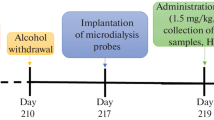Abstract
Rats were given chronic treatments with ethanol in two ways: by offering 10% ethanol in water as the only liquid supply for 34 weeks and by exposing the rats to ethanol vapour during 5 h daily for 7 weeks. In this way blood ethanol levels of 1.4–2.3 and 5.5–6.9 mg/ml, respectively, were accomplished. In neither of the cases was brain monoamine oxidase activity changed.
The result supports an hypothesis previously advanced that the lowered monoamine oxidase activity found in the brain of a suicide patient was not due to a direct effect of ethanol on alcoholics in the suicide group, but that the low enzyme activity reflected a low monoaminergic activity in the brains of the patients in the suicide group.
Similar content being viewed by others
References
Ahtee, L., Eriksson, K.: 5-Hydroxytryptamine and 5-hydroxyindolylacetic acid content in brain of rat strains selected for their alcohol intake. Physiol. and Behav. 8, 123–126 (1972)
Curry, A. S., Walker, G. W., Simpson, G. S.: Determination of ethanol in blood by gas chromatography. Analyst 91, 742–743 (1966)
Deitrich, R., Erwin, G.: Involvement of biogenic amine metabolism in ethanol addiction. Fed. Proc. 34, 1962–1968 (1975)
McEwen, C., Cohen, J.: An amine oxidase in normal human serum. J. Lab. clin. Med. 62, 766–776 (1963)
Gottfries, C. G., Oreland, L., Wiberg, Å., Winblad, B.: Lowered monoamine oxidase activity in brains from alcoholic suicides. J. Neurochem. 25, 667–673 (1975)
Gray, E. G., Whittaker, W. P.: The isolation of nerve endings from brain: an electron microscopic study of cell fragments derived by homogenization and centrifugation. J. Anat. (Lond.) 96, 79–87 (1962)
Lowry, O. H., Rosebrough, A., Farr, L., Randall, R.: Protein measurement with the Folin phenol reagent. J. biol. Chem. 193, 265–275 (1951)
Neff, N. H., Yang, H. Y. T.: Another look at the monoamine oxidases and the monoamine oxidase inhibitor drugs. Life Sci. 14, 2061–2074 (1974)
Oreland, L., Ekstedt, B.: Soluble and membrane-bound pig liver mitochondrial monoamine oxidase: thermostability tryptic digestability and kinetic properties. Biochem. Pharmacol. 21, 2479–2488 (1972)
Wahlström, G.: Cross tolerance between hexobarbital and ethanol in rats induced by forced drinking of intoxicating amounts of ethanol. The Finnish foundation for alcoholic studies 20, 241–249 (1972)
Wahlström, G., Widerlöf, E.: Interaction and acute cross tolerance between ethanol and hexobarbitone in the rat. J. Pharm. Pharmacol. 23, 58–60 (1971)
Wiberg, Å., Gottfries, C. G., Oreland, L.: Low platelet MAO activity in human alcoholics. Med. Biol. (in press, 1977)
Wurtman, R. J., Axelrod, J.: A sensitive and specific assay for the estimation of monoamine oxidase. Biochem. Pharmacol. 12, 1439–1441 (1963)
Åsberg, M., Träskman, L., Thorén, P.: 5-HIAA in the cerebrospinal fluid: a biochemical suicide predictor? Arch. gen. Psychiat. (in press)
Author information
Authors and Affiliations
Rights and permissions
About this article
Cite this article
Wiberg, Å., Wahlström, G. & Oreland, L. Brain monoamine oxidase activity after chronic ethanol treatment of rats. Psychopharmacology 52, 111–113 (1977). https://doi.org/10.1007/BF00439095
Received:
Accepted:
Issue Date:
DOI: https://doi.org/10.1007/BF00439095



